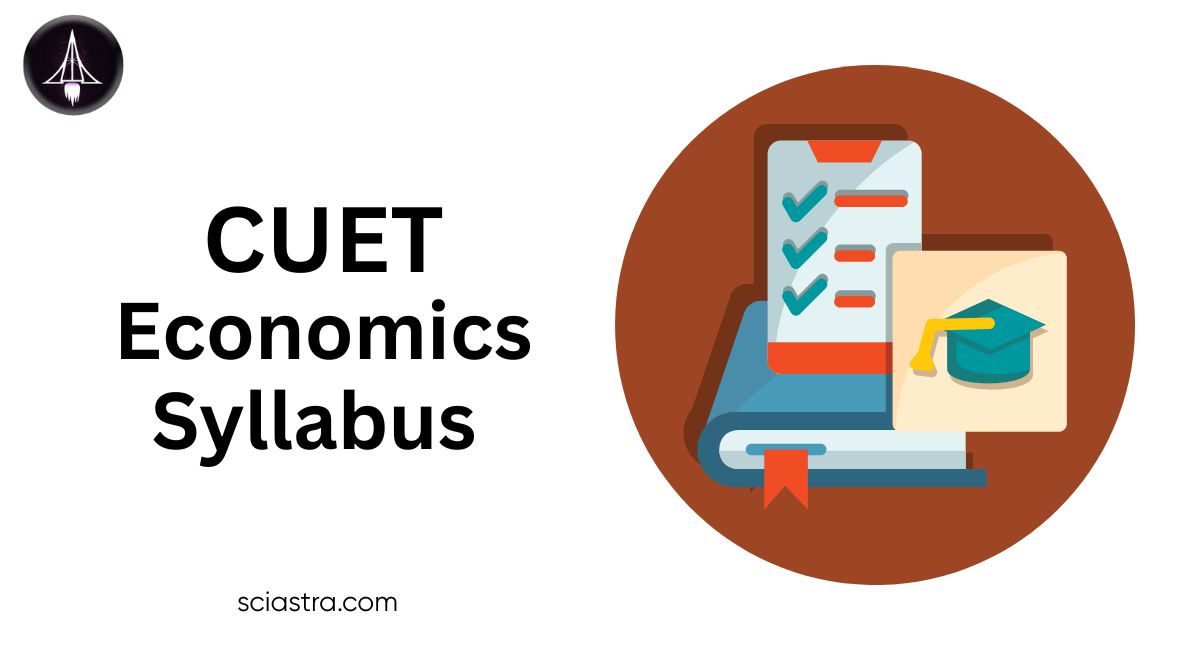CUET 2026 Economics Syllabus: Expertise in Economics is a highly sought-after skill in today’s job market. It plays a key role in helping nations and organisations with financial planning and strategy-making, which are crucial for their growth. Therefore, many Indian students aspire to study Economics and build a career in this field.If you are one of them, you can appear for the CUET 2026 for Economics, as it can be your gateway to top Indian universities such as DU, BHU and JNU to pursue a UG Economics course. To guide you in your preparation, SciAstra has provided the complete details about the CUET Economics syllabus 2026 in this article. You can also find details here about the CUET Economics exam pattern, the official syllabus PDF, recommended books, and preparation tips.The CUET 2026 syllabus for Economics will be released in the first week of March 2026 (tentative) on the official CUET website – cuet.nta.nic.in. Meanwhile, candidates can check details based on the previous year’s syllabus.
CUET 2026 Economics Exam Pattern
Before filling out the CUET 2026 application form and appearing for the Economics exam, candidates must check the CUET 2026 exam pattern for the subject. Check out the exam pattern details below:
Section | Number of Questions | Duration | Question Types |
Section IA & IB – Language | 50 Questions | 60 minutes (for each chosen language) | Reading Comprehension based on different types of passages – Factual, Literary, and Narrative. Includes testing of Literary Aptitude and Vocabulary. |
Section II – Domain Subjects | 50 Questions | 60 minutes | MCQs based on the Class 12 NCERT syllabus. Input text may be provided for certain questions. |
Section III – General Test | 50 Questions | 60 minutes | MCQs based on:
|
Subject Mapping for BCom Economics | Section I: EnglishSection II: Economics + Any 2 domain subjectsSection III: General Aptitude Test | ||
Also Read:
CUET 2026 Economic Syllabus
The CUET Economics syllabus includes topics from Mircoeconomics and Macroeconomics. Find below the list of all the topics and subtopics included in the syllabus:
Topics | Subtopics | Areas Covered |
Introductory Microeconomics | Introduction |
|
Consumer Behaviour and Demand |
| |
Producer Behaviour and Supply |
| |
Forms of Market and Price Determination | Forms of market: perfect competitionPrice determination under perfect competition – equilibrium priceEffects of shifts in demand and supply | |
Applications of Demand and Supply Tools |
| |
Introductory Macroeconomics | National Income and Related Aggregates |
|
Determination of Income and Employment |
| |
Money and Banking |
| |
Government Budget and the Economy |
| |
Balance of Payments |
|
CUET Previous Year’s Economics Syllabus
The CUET 2026 syllabus for Economics will be similar to the previous year’s syllabus for the subject. Therefore, candidates can refer to the previous syllabus and begin their exam preparation. The PDF is provided below:
CUET 2025 Syllabus PDF (Official) |
CUET 2026 Economic Syllabus PDF
The CUET 2026 syllabus is likely to be released in the first week of March 2026 at cuet.nta.nic.in. SciAstra will provide the syllabus PDF once it is released:
CUET 2026 Syllabus PDF (Official) | To be released |
CUET Economic Previous Year Question Paper PDF
The CUET previous years’ question papers can help candidates with the exam preparation by highlighting important questions and topics for the exam. To support CUET 2026 Economics preparation, SciAstra has provided previous years’ question papers for the subject. Check out the PDFs below:
CUET 2025 Question Paper (Official) | |
CUET 2024 Question Paper (Official) | |
CUET 2023 Question Paper (Official) | |
CUET 2022 Question Paper (Official) |
Also Read:
CUET 2026 Economics Recommended Books
The CUET 2026 preparation books by credible and reputed authors and publishers can guide candidates in their exam preparation. They cover questions and topics that are relevant to the exam syllabus and are likely to be asked in the exam. The CUET 2026 preparation books for Economics by credible and reputed authors and publishers are the following:
Book Name | Author/Publisher |
Introductory Microeconomics | NCERT |
Introductory Macroeconomics | NCERT |
Principles of Microeconomics | N. Gregory Mankiw |
Principles of Macroeconomics | N. Gregory Mankiw |
Indian Economy | Ramesh Singh |
Statistics for Economics | NCERT |
CUET UG Economics Question Bank | Oswaal Books |
CUET Economics Previous Years’ Question Papers | Arihant Experts |
CUET Economics Guide | MTG Editorial Board |
CUET 2026 Economics Exam Preparation Tips
Effective CUET 2026 preparation tips for the Economics test can help candidates use the available time optimally and perform well in the exam. For this reason, SciAstra has listed the most effective preparation topics for the CUET 2026 Economics exam:
Thoroughly study the NCERT Class 11 and Class 12 Economics books, as many questions in the exam are based on the concepts covered in these books.
Focus on core Economics theories and models, including demand-supply analysis, elasticity, production, costs, revenue, market structures, and national income accounting. These concepts are the foundation of economics, and studying them will strengthen your understanding of the subject.
Avoid rote learning, as it may cause confusion. Instead, try to understand the concepts. Use the recommended books to learn the main ideas with the help of examples.
Solve CUET Economics PYQs and sample papers to get familiar with the type of questions asked.
Take timed mock tests to improve both speed and accuracy.
Conclusion
CUET 2026 Economics syllabus covers concepts from Macroeconomics and Microeconomics. Most of these concepts are from the NCERT Class 11 and Class 12 Economics books. Thus, studying these books thoroughly can help candidates score well in the exam. The important Economics theories and models for the exam include demand-supply analysis, elasticity, production, costs, revenue, market structures, and national income accounting. These concepts form the foundation of economics, and studying them will strengthen your understanding of the subject.Read More:

Leave a comment